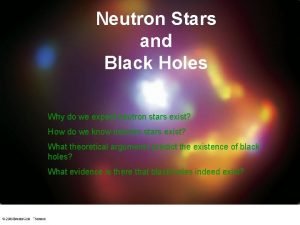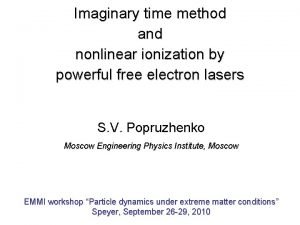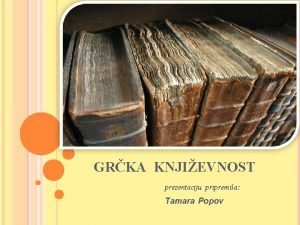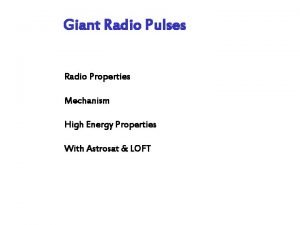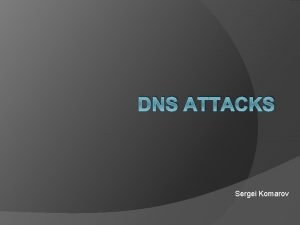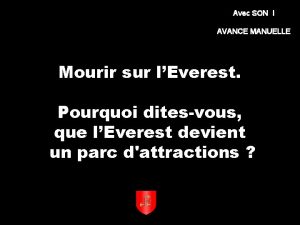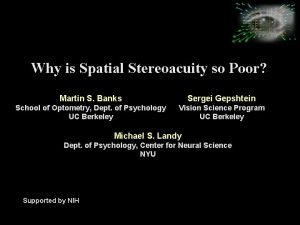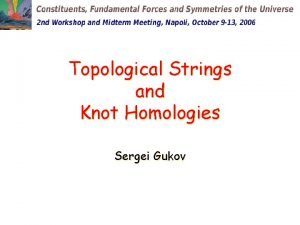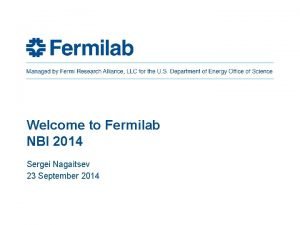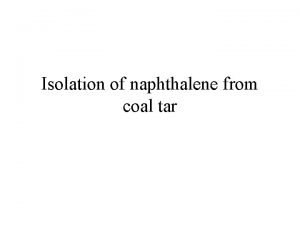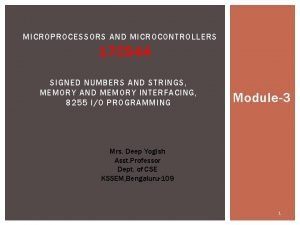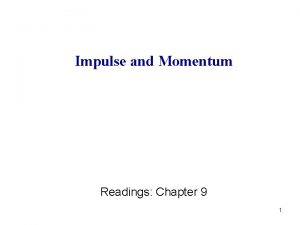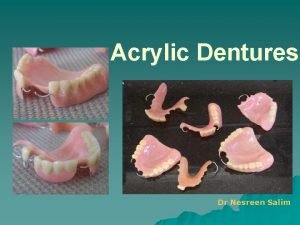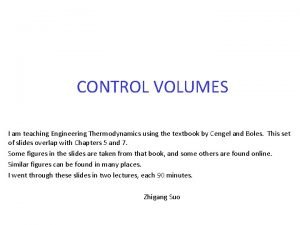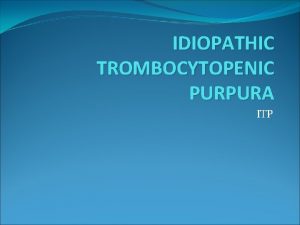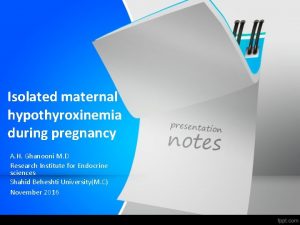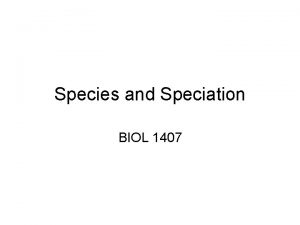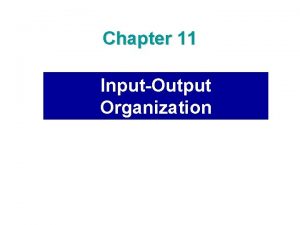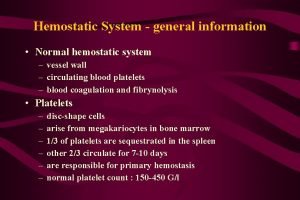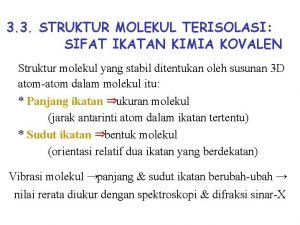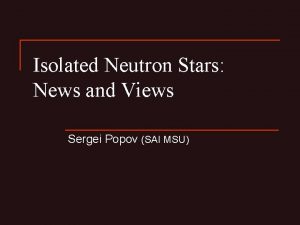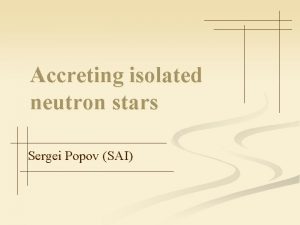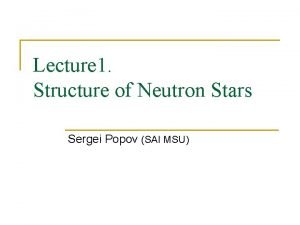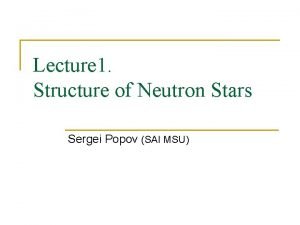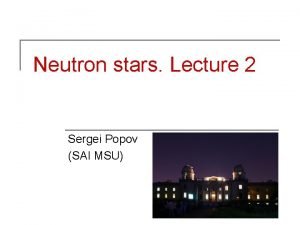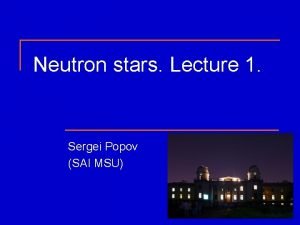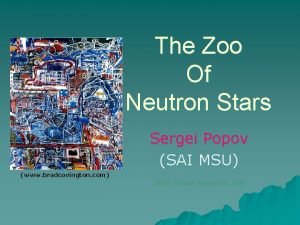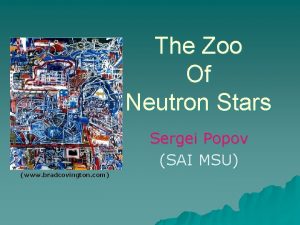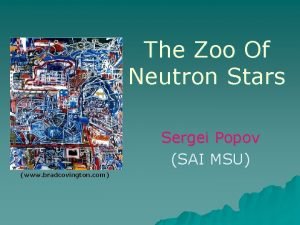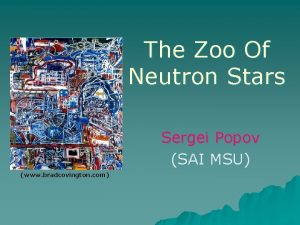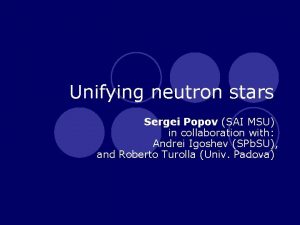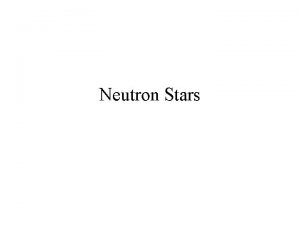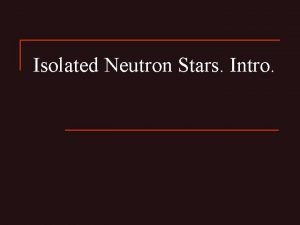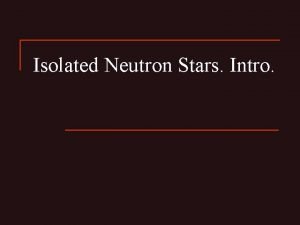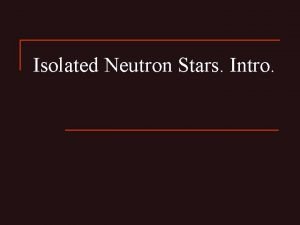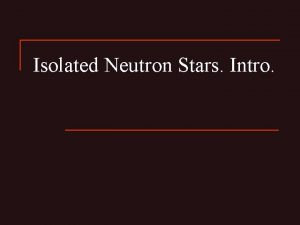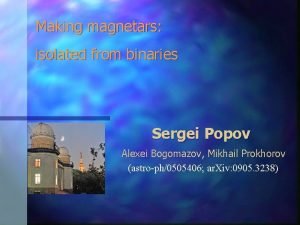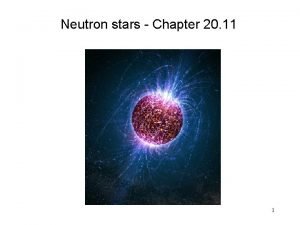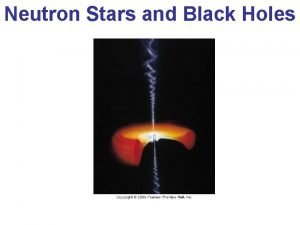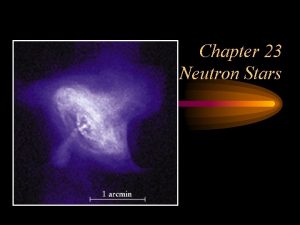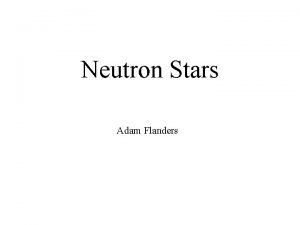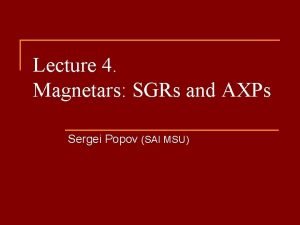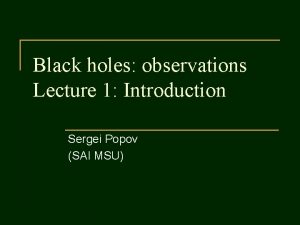Lecture 1 Isolated Neutron Stars Intro Sergei Popov



































![Population synthesis of close-by NS and GWs Palomba [astro-ph/0503046] The author assumes that some Population synthesis of close-by NS and GWs Palomba [astro-ph/0503046] The author assumes that some](https://slidetodoc.com/presentation_image_h2/06bd4a8ec1523099ffee4c8072d33b6c/image-36.jpg)


- Slides: 38

Lecture 1 Isolated Neutron Stars. Intro. Sergei Popov (SAI MSU) Dubna “Dense Matter In Heavy Ion Collisions and Astrophysics”, July 2008

Artistic view 2

Prediction. . . Neutron stars have been predicted in 30 s: L. D. Landau: Star-nuclei (1932) + anecdote Baade and Zwicky: neutron stars and supernovae (1934) (Landau) (Zwicky) (Baade) 3

Good old classics For years two main types of NSs have been discussed: radio pulsars and accreting NSs in close binary systems The pulsar in the Crab nebula A binary system 4

The old zoo of neutron stars In 60 s the first X-ray sources have been discovered. They were neutron stars in close binary systems, BUT. . . . they were «not recognized» . . Now we know hundreds of X-ray binaries with neutron stars in the Milky Way and in other galaxies. 5

Rocket experiments Sco X-1 Giacconi, Gursky, Hendel 1962 In 2002 R. Giacconi was awarded with the Nobel prize. 6

Discovery !!!! 1967: Jocelyn Bell. Radio pulsars. Seredipitous discovery. 7

The pulsar in the Crab nebula 8

The new zoo of neutron stars During last >10 years it became clear that neutron stars can be born very different. In particular, absolutely non-similar to the Crab pulsar. o Compact central X-ray sources in supernova remnants. o Anomalous X-ray pulsars o Soft gamma repeaters o The Magnificent Seven o Unidentified EGRET sources o Transient radio sources (RRATs) o Calvera …. 9

Compact central X-ray sources in supernova remnants Cas A Problem: small emitting area RCW 103 6. 7 hour period 10 (de Luca et al. 2006, 0803. 1373 )

Puppis A One of the most famous central compact X-ray sources in supernova remnants. Age about 3700 years. Probably the progenitor was a very massive star (mass about 30 solar). Vkick=1500 km/s Winkler, Petre 2006 (astro-ph/0608205) See a review on these objects in arxiv: 0712. 2209 11

Magnetars n n d. E/dt > d. Erot/dt By definition: The energy of the magnetic field is released P-Pdot Direct measurements of the field (Ibrahim et al. ) Magnetic fields 1014– 1015 G 12

Known magnetars SGRs n 0526 -66 n 1627 -41 n 1806 -20 n 1900+14 n +candidates (СТВ 109) AXPs n CXO 010043. 1 -72 n 4 U 0142+61 n 1 E 1048. 1 -5937 n CXOU J 164710. 3 n 1 RXS J 170849 -40 n XTE J 1810 -197 n 1 E 1841 -045 n AX J 1844 -0258 n 1 E 2259+586 n +candidates and transients 13

SGRs: monitoring and extra. G SRG detectors can contribute to observations of SGRs. Now there are few other candidates (Mazets et al. , Frederiks et al. , Golenetskii et al. , Ofek et al, Crider. . ), including one in the direction of M 31 (Mazets et al. arxiv: 0712. 1502). [D. Frederiks et al. astro-ph/0609544] 14

QPOs after giant flares A kind of quasi periodic oscillations have been found in tail of two events (aug. 1998, dec. 2004). They are supposed to be torsional oscillations of NSs, however, it is not clear, yet. (Israel et al. 2005 astro-ph/0505255, Watts and Strohmayer 2005 astro-ph/0608463) See a recent review in a. Xiv: 0710. 2475 15

Transient radio emission from AXP Radio emission was detected from XTE 1810 -197 during its active state. One another magnetar was reported to be detected at low frequencies in Pushchino, however, this result has to be checked. (Camilo et al. astro-ph/0605429) 16

Another AXP detected in radio 1 E 1547. 0 -5408 P= 2 sec SNR G 327. 24 -0. 13 arxiv: 0711. 3780, 0802. 0494 17

Transient radiopulsar PSR J 1846 -0258 P=0. 3 sec B=5 1013 G The pulsar increased its luminosity in X-rays. Magnetar-like X-ray bursts. 0802. 1242, 0802. 1704 18

ROSAT ROentgen SATellite German satellite (with participation of US and UK). Launched 01 June 1990. The program was successfully ended on 12 Feb 1999. 19

Close-by radioquiet NSs n n n Discovery: Walter et al. (1996) Proper motion and distance: Kaplan et al. No pulsations Thermal spectrum Later on: six brothers RX J 1856. 5 -3754 20

Magnificent Seven Name Period, s RX 1856 7. 05 RX 0720 8. 39 RBS 1223 10. 31 RBS 1556 6. 88? RX 0806 11. 37 RX 0420 3. 45 RBS 1774 9. 44 Radioquiet (? ) Close-by Thermal emission Absorption features Long periods 21

Unidentified EGRET sources Grenier (2000), Gehrels et al. (2000) Unidentified sources are divided into several groups. One of them has sky distribution similar to the Gould Belt objects. It is suggested that GLAST (and, probably, AGILE) Can help to solve this problem. Actively studied subject (see for example papers by Harding, Gonthier) No radio pulsars in 56 EGRET error boxes (Crawford et al. 2006) 22

Pulsars invisible in radio? (Grenier astro-ph/0011298) 23

Discovery of radio transients Mc. Laughlin et al. (2006) discovered a new type of sources– RRATs (Rotating Radio Transients). For most of the sources periods about few seconds were discovered. The result was obtained during the Parkes survey of the Galactic plane. These sources can be related to The Magnificent seven. Thermal X-rays were observed from one of the RRATs (Reynolds et al. 2006). This one seems to me the youngest. 24

P-Pdot diagram for RRATs Mc. Laughlin et al. 2006 Nature Estimates show that there should be about 400 000 Sources of this type in the Galaxy. Young or old? ? ? Relatives of the Magnificent seven? (astro-ph/0603258) 25

RRATs n n n 11 sources detected in the Parkes Multibeam survey (Mc. Laughlin et al 2006) Burst duration 2 -30 ms, interval 4 min-3 hr Periods in the range 0. 4 -7 s Period derivative measured in 3 sources: B ~ 1012 -1014 G, age ~ 0. 1 -3 Myr RRAT J 1819 -1458 detected in the X-rays, spectrum soft and thermal, k. T ~ 120 e. V (Reynolds et al 2006) 26

RRATs n n n P, B, ages and X-ray properties of RRATs very similar to those of XDINSs Estimated number of RRATs ~ 3 -5 times that of PSRs If τRRAT ≈ τPSR, βRRAT ≈ 3 -5 βPSR βXDINS > 3 βPSR (Popov et al 2006) Are RRATs far away XDINSs ? 27

RRATs. Recent data X-ray pulses overlaped on radio data of RRAT J 1819 -1458. (ar. Xiv: 0710. 2056, see there also a brief review on these sources) 28

Calvera et al. Recently, Rutledge et al. reported the discovery of an enigmatic NS candidated dubbed Calvera. It can be an evolved (aged) version of Cas A source, but also it can be a M 7 -like object, who’s progenitor was a runaway (or, less probably, hypervelocity) star. No radio emission was found (arxiv: 0710. 1788 ). 29

LOFAR Low Frequency Array (<250 MHz) Perfect for wide-field observations, search for transients in radio etc. See a brief review in arxiv: 0710. 0675 30

Gravitational waves from INSs INS are expected to be sources of GWs: • Radio pulsars • Young magnetars • . . . . ? • Know periods • Rapid rotation and strong deformation • Possible new types sources 31

Recent LIGO results for PSRs 1. 0805. 4758 Beating the spin-down limit on gravitational wave emission from the Crab pulsar h 095% < 3. 5 10 -25 ε<1. 9 10 -4 (single template) 2. 0708. 3818 All-sky search for periodic grav. waves in LIGO S 4 data 50 -1000 HZ No evidence. Upper limits on isolated NSs GW emission. Very weak limits for “dark” sources (<50 pc for ε~ 10 -6) 3. gr-qc/0702039 Upper limits on gravitational wave emission from 78 PSRs ε< 10 -6 for PSR J 2124− 3358 h<2. 6× 10− 25 for PSR J 1603− 7202 32

GWs from young magnetars A newborn magnetar with msec period and toroidal magnetic field B~1016 G for few days can be a strong source detectable from the Virgo cluster distance by advanced LIGO. Birthrate of magnetars in Virgo is about 0. 3 -1 per year. Due to strong toroidal magnetic fields young magnetars can have prolate shape with ellipticity 10 -3 – 10 -4. Power of the signal goes as ~P-6. Instantaneous signal astro-ph/0702075 Dall’Osso et al. astro-ph/0511068 Stella et al. 33

Detectability by The advanced LIGO signal is observable for several periods So, the signal lasts for several days after a magnetar’s birth It is possible to get very optimistic predictions for advanced LIGO. However, mining the data for a signal with uknown parameters from unknown place in the sky is very complicated. Computational costs are very large. astro-ph/0702075 Dall’Osso et al. 34

Magnetar parameters Estimating GW emission form magnetars it is necessary to make assumptions avout ellipticity. It is not that easy. 0712. 2162 Pons et al. Relativistic models of magnetars: structure and deformations This authors estimate that for B~1015 G ellipticity is expected ~10 -6 – 10 -5 In extreme cases (low-mass NSs) it can go up to 10 -3 Crustal field are very important. 0806. 2794 Regimbau, Mandic Astrophysical sources of stochastic GW background Magnetars produce strong (in comparison with expected cosmological signal) background around 1 k. Hz (depends on initil spin of magnetars). Next generation of interferometers will give important results on NSs. 35
![Population synthesis of closeby NS and GWs Palomba astroph0503046 The author assumes that some Population synthesis of close-by NS and GWs Palomba [astro-ph/0503046] The author assumes that some](https://slidetodoc.com/presentation_image_h2/06bd4a8ec1523099ffee4c8072d33b6c/image-36.jpg)
Population synthesis of close-by NS and GWs Palomba [astro-ph/0503046] The author assumes that some fraction of NSs are born with low magnetic fields, so that GW losses dominate in spin-down. The author predicts that few NSs can be detected by Virgo (for not too small fraction of low-field NSs), and tens – by advanced Virgo. Expected distances (for Virgo) are 100 -300 pc, and frequences about 200 -600 Hz. 36

n There are several types of sources: CCOs, M 7, SGRs, AXPs, RRATs. . . Magnetars (? ) Significant fraction of all newborn NSs Unsolved problems: 1. Are there links? 2. Reasons for diversity Conclusion n 37

Main reviews • NS basics: physics/0503245 astro-ph/0405262 • SGRs & AXPs: astro-ph/0406133 • CCOs: astro-ph/0311526 0712. 2209 • Quark stars: astro-ph/0608360 • The Magnificent Seven: astro-ph/0502457 astro-ph/0609066 0801. 1143 • RRATs: astro-ph/0511587 • Cooling of NSs: astro-ph/0508056 astro-ph/0402143 • NS structure astro-ph/0608360 • NS interiors ar. Xiv: 0705. 2708 • Magnetic field of NSs ar. Xiv: 0802. 2227 0711. 3650 • Eo. S astro-ph/0612440 • NS atmospheres astro-ph/0206025 38
 How are neutron stars formed
How are neutron stars formed Buydrm pricing
Buydrm pricing Jurij popov
Jurij popov Aleksa popov
Aleksa popov Future dmitry
Future dmitry Popov
Popov Tamara popov
Tamara popov Popov
Popov Mary daniels is a student in england
Mary daniels is a student in england Sergei komarov contact info
Sergei komarov contact info Sergei sedov
Sergei sedov Francys arsentiev
Francys arsentiev July 1969
July 1969 Philippe denain monaco
Philippe denain monaco What of this goldfish would you wish theme
What of this goldfish would you wish theme Sergei gepshtein
Sergei gepshtein Sergei naryškin
Sergei naryškin Sergei gukov
Sergei gukov Sergei nagaitsev
Sergei nagaitsev 01:640:244 lecture notes - lecture 15: plat, idah, farad
01:640:244 lecture notes - lecture 15: plat, idah, farad Throating in building construction
Throating in building construction Isolated feature combined feature effects
Isolated feature combined feature effects How is naphthalene isolated from coal tar
How is naphthalene isolated from coal tar What is isolated i/o
What is isolated i/o Why did some ancient greek settlements trade?
Why did some ancient greek settlements trade? Isolated system
Isolated system Special-purpose op-amp circuits
Special-purpose op-amp circuits Isolated systolic hypertension
Isolated systolic hypertension Spoon denture design
Spoon denture design Middle level clouds
Middle level clouds Is the earth a closed system
Is the earth a closed system Nozzle and diffuser
Nozzle and diffuser Trombocytopenic purpura
Trombocytopenic purpura Isolated maternal hypothyroxinemia
Isolated maternal hypothyroxinemia Habital isolation
Habital isolation Memory mapped io diagram
Memory mapped io diagram Cirrus clouds are composed primarily of
Cirrus clouds are composed primarily of Isolated thrombocytopenia
Isolated thrombocytopenia Ikatan kovalen polar
Ikatan kovalen polar
